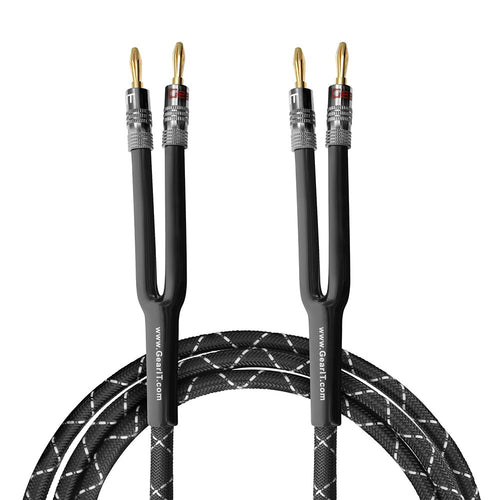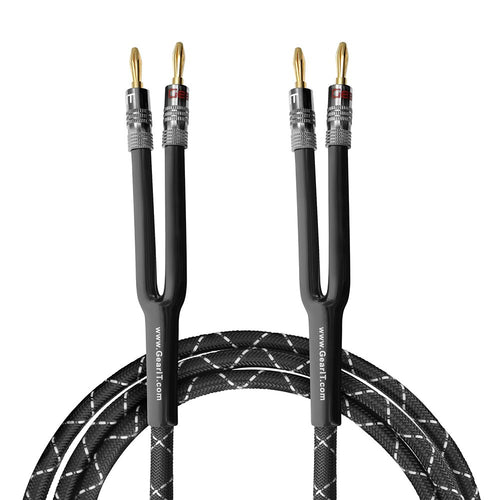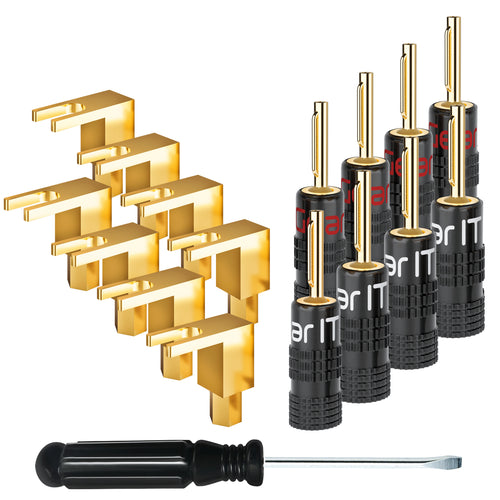Ever tried to tidy up the spaghetti mess of speaker wires in your home setup? Banana plugs might be the neat solution you’ve been searching for.
They provide a secure and easy way to connect speaker wires, improving both the aesthetic and functionality of your audio system. You’ll find that once these plugs are installed, connecting and disconnecting your speakers becomes a breeze.
This article will guide you through the simple steps to install banana plugs and help you choose the right type for your needs.
You won't have to worry about exposed wires or hard-to-reach connections anymore. Keep reading to discover how this small tool can make a big difference in your sound experience.
What Are Banana Plugs and Why Use Them?
Banana plugs are small connectors used to join speaker wires to audio devices. They have a cylindrical shape and fit into banana jacks. This provides a neat and organized way to connect audio equipment.
Benefits of banana plugs include creating secure connections. This reduces the risk of wires becoming loose or frayed. It can also improve sound quality by maintaining a consistent signal path.
You may find banana plugs convenient for home theaters and professional audio setups. They simplify the process of plugging and unplugging wires, saving time and effort. They are essential for reducing clutter and keeping your setup tidy.
Commonly, banana plugs are color-coded. Red and black help you easily identify positive and negative terminals. This makes them user-friendly, especially when setting up complex sound systems, like those in a home theater.
Also read: 🔗 Banana Plugs vs Bare Wire: Which is Better for Your Setup?
Why Use a Banan Plug?
Using banana plugs, you ensure a reliable connection. This enhances the performance of your audio system, whether it's a simple sound setup or a sophisticated home cinema. With benefits like improved sound quality and durability, they are a valuable addition to any audio system.
Banana plugs are especially useful when you frequently move or adjust your setup. The easy plug-and-unplug feature means you can make changes quickly and effortlessly. Overall, banana plugs add both functionality and aesthetic appeal to your audio system.
Tools and Materials Needed for Installing Banana Plugs
Before starting, gather the necessary equipment and materials to ensure a smooth installation process. Having the right items will make the task easier and help you achieve a solid connection.
Required Tools:
-
Wire Cutters: To trim and prepare the speaker wire efficiently.
-
Screwdriver: Useful if your banana plugs require tightening or have a screw-on mechanism.
-
Banana Plugs: Choose high-quality plugs that fit your system.
Optional Items:
-
Electrical Tape: Can be used for additional insulation if you feel it's necessary.
-
Multimeter: Helpful for testing and ensuring your connections are working properly.
It's wise to keep these optional items nearby, as they can improve the reliability of your connections. These tools for installing banana plugs will ensure that the project is straightforward and successful.
By preparing in advance, you'll save time and avoid frustration when connecting your speaker system.
Step-by-Step Guide to Install Banana Plugs
The photo above shows how to install banana plugs on speaker wires.
Step 1: Strip the Wire
Use a wire stripper to carefully strip about 1/2 inch of insulation from the end of the speaker wire. Make sure not to cut the copper strands inside. This will expose the wire without causing any damage.
Step 2: Separate the Strands
Gently twist the exposed copper strands together to keep them neat and to ensure a better connection. This will help when inserting them into the banana plug, as it reduces fraying.
Step 3: Attach the Banana Plug
For screw-on banana plugs, insert the twisted wire into the plug's hole. Tighten the screw to secure the wire. If your banana plug requires soldering, heat the connection and add a small amount of solder to keep the wire in place.
Step 4: Test the Connection
Connect the banana plug to your audio equipment. Turn on your device and listen for clear sound. This confirms that the installation is successful. If there are issues, recheck all connections.
Banana plugs make connecting and disconnecting speaker wires much simpler and more efficient, especially when used with devices that require frequent maintenance or adjustments.
They ensure a strong and secure audio connection, enhancing your listening experience.
Types of Banana Plugs and Which One to Choose
When it comes to banana plugs, choosing the right type can enhance your audio experience. Here are some common types and their features:
Screw-on Banana Plugs
-
Pros: Easy to install without special tools. Just tighten the screws for a secure connection.
-
Cons: May require occasional retightening.
-
Best for: Home audio setups and speaker connections.
Solder-type Banana Plugs
-
Pros: Provides a very secure and long-lasting connection.
-
Cons: Requires soldering skills and tools.
-
Best for: Permanent and professional setups. Ideal if you have the tools and expertise.
Compression Banana Plugs
-
Pros: Offers excellent connection with minimal effort. No soldering required.
-
Cons: Slightly more expensive than other plugs.
-
Best for: Quick installations and reliable connections without soldering. Great for both home and professional use.
Choosing the best banana plug for your speakers depends on your needs. For simple home setups, screw-on plugs are convenient and affordable.
If you’re setting up a professional audio system, solder-type plugs might be worth the effort. For a balance of ease and reliability, consider compression plugs.
Each type has its strengths, so weigh these according to your use case.
Common Mistakes to Avoid When Installing Banana Plugs
Stripping too much wire
-
Stripping excessive insulation can lead to poor connections. Strip only enough so the bare wire fits snugly into the plug.
Failing to secure the plug properly
-
Use tools like needle-nose pliers to tighten connections. Loose plugs may come undone over time.
Selecting the wrong type of banana plug
-
Some plugs are specific to certain terminals. For example, pin-type banana plugs are designed for spring-clip terminals. Choose the correct plug for your equipment.
Ignoring connection issues when sound quality is poor
-
Check and re-tighten any loose or incomplete connections, as these are common causes of sound problems.
Overlooking frayed or damaged wires
-
Inspect the wires for damage, as it can impact performance. Replace or repair damaged wires promptly.
Skipping additional support measures
-
Use electrical tape or wire ties to secure wires, preventing the plugs from coming loose over time.
Conclusion: Simplify Your Audio Setup with Banana Plugs
Banana plugs make connecting speakers easier, safer, and more reliable. They improve sound quality and prevent messy or frayed wires.
Follow the steps in this guide to quickly install them and enjoy a hassle-free audio setup.
Ready to upgrade your sound system? Check out GEARit’s high-quality banana plug cables at GEARit.com and take your audio experience to the next level!
Frequently Asked Questions
When working with banana plugs, there are a few common questions that many people have. This section addresses tools you might need, compatibility with different speaker wires, and how to connect banana plugs to various devices.
Do I need special tools to install banana plugs?
No special tools are needed. Most banana plugs come with their own screw mechanisms, which you can easily tighten by hand. In some cases, a small screwdriver can help make the connection secure.
Can I use banana plugs with all types of speaker wires?
Yes, banana plugs can be used with most speaker wires. It's important to ensure that the wire gauge is compatible with the plug. Most plugs accept a wide range of wire gauges, making them versatile for different setups.
What is the difference between solder-type and screw-on banana plugs?
Solder-type plugs provide a permanent, stable connection by melting solder to attach the wire. Screw-on plugs are easier to use, as they allow you to attach the wire by simply fastening screws, providing flexibility to change connections without soldering.
How to install banana plugs into receiver?
To attach banana plugs to a receiver, first ensure that the receiver has banana plug-compatible ports. Insert the plug into the port until it fits snugly. This can often enhance the stability of your connection compared to bare wires.
How to connect banana plugs to TV?
Connecting banana plugs directly to a TV can be challenging because most TVs lack binding posts. Instead, connect your speaker using a receiver that supports banana plugs, then connect the receiver to the TV using the appropriate audio outputs.
Do banana plugs fit all speakers?
Many speakers are compatible with banana plugs, but not all. It is essential to check if your speaker has binding posts that accept banana plug connections. If not, you may need to use other types of connectors like spades or bare wires.






















































